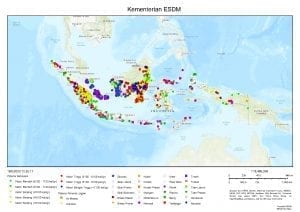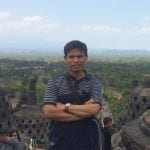Orang bilang tanah kita tanah surga – Kolam Susu song lyrics, Koes Plus.


The distribution of coal & mineral geological resources potential in Indonesia (Source: Kementerian ESDM, 2020)
Orang bilang tanah kita tanah surga, tongkat kayu dan batu jadi tanaman. This is a fragment of the “Kolam Susu” lyric, a famous song by the legendary Indonesian band, Koes Plus. The lyric illustrates how rich our country is on natural resources whether it is marine, forests, or geological resources. It is indeed no exaggeration to state that Indonesia is a country with abundance of geological resources. Based on data from the Ministry of Energy and Mineral Resources in 2020, puts Indonesia in the 6th rank in the world for the one of the countries with greatest wealth of geological resources. As shown in the picture above, Indonesia as an archipelago from Sabang to Merauke has scattered various types of geological resources. Those are radioactive, metallic, non-metallic, coal, and rock minerals (UU No. 4 of 2009). This resource condition is inseparable from the regional geological condition in which continental and oceanic plates meets (subduction zones). Moreover, the fact that Indonesia lies in the ring of fire surely impacts the process of geological resources formation.
There are several types of metallic geological resources namely: iron, primary gold, copper, nickel, bauxite, and silver as Indonesia’s major commodities. Based on the data from Badan Geologi in 2018, copper resource is about 12.468,35 million tons, iron of 12.079,45 million tons, primary gold of 11.402,33 million tons, nickel of 9.311,06 million tons, silver of 6.433,01 million tons, bauxite of 3.301,33 million tons and tin of 3.878,29 million tons. Bauxite is commonly found in Kepulauan Riau and West Kalimantan, while nickel is abundantly reserved in Sulawesi, Maluku, and West Papua (Gag Island). As for tin, the reserve is abundantly deposited in Bangka Belitung and Riau. Last but not least is gold that is found in several regions, i.e., Sumatra, Java, Kalimantan, and Papua. Aside from these metallic minerals, Indonesia also has geological resources for non-metallic minerals such as zeolites, quartz sand, carbonate rocks, marble, granite, sirtu (sand and stone), and other minerals and non-metal rocks that is distributed along Indonesia’s region.

Another geological resource in Indonesia is energy resources. Those are coal, oil and gas, as well as geothermal. Coal can be found across the island of Sumatra, Kalimantan, and Papua. Indonesia’s proven coal reserves are 3.5% of the world’s proven total reserves (Ariyono, 2020 on the https://www.esdm.go.id). Instead of coal, Indonesia has geothermal that is classified as renewable energy with low carbon dioxide emissions. About 40% of the world’s geothermal energy reserves are stored in Indonesia located mainly in Sumatra, Java, and Bali (investments.com). Meanwhile, oil and gas can be found in basins across Papua, Java, Sumatra, and Kalimantan. These aforementioned facts show how fortunate Indonesia abundantly possesses geological resources.
The existence of “these” abundant geological resources can be used to support the progress and resilience of the country. However, we should not take it for granted, because it can deplete significantly if we do not manage sustainably (read the article: What is geological resources?). A systematic and sustainable management system is needed so that they can last for generations to come. We must actively participate in protecting our nature and resources, and strive to find non-conventional resources for the better Indonesia. This article is expected to depict the condition and potential of Indonesia’s geological resources, and the need to preserve them sustainably.
Source:
- ESDM,Sumber Daya Mineral : Batubara 104.760 Juta Ton, Emas 4.250 Ton, Tembaga 68.960 Ribu Ton, 2009 https://www.esdm.go.id/id/media-center/arsip-berita/sumber-daya-mineral-batubara-104760-juta-ton-emas-4250-ton-tembaga-68960-ribu-ton
- ESDM, Bertemu Media, Dirjen Minerba Jelaskan Potensi Sumber Daya dan Cadangan Minerba, 2020 https://www.esdm.go.id/id/media-center/arsip-berita/bertemu-media-dirjen-minerba-jelaskan-potensi-sumber-daya-dan-cadangan-minerba
- Herman Wahyudhi “Tambang untuk kehidupan yang lebih baik”, 2016 https://www.kompasiana.com/bacabaca/58287f851e23bd88277531d5/tambang-untuk-kehidupan-yang-lebih-baik?page=all
- Mineral Strategis di Kabupaten/Kota, 2015 http://webmap.psdg.bgl.esdm.go.id/geosain/neraca-mineral-strategis.php?mode=administrasi
- https://geoportal.esdm.go.id/minerba/#


Follow Us!